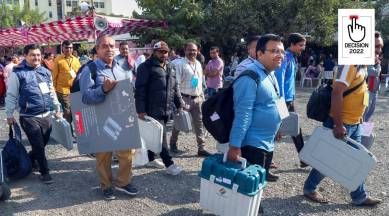Phase-1 polling: Final turnout at 63 pc, says EC; less than 2017 figures
The provisional voter turnout, which stood at 61 per cent Thursday night, crawled northwards during the day until the final figures were declared by EC at 6 pm Friday.

Gujarat recorded 63.31 per cent voter turnout in Phase-1 of the Assembly election, according to the final figures released by the Election Commission Friday. The figure is lower than 66.79 per cent recorded for the same phase in the 2017 election.
The provisional voter turnout, which stood at 61 per cent Thursday night, crawled northwards during the day until the final figures were declared by EC at 6 pm Friday. “A lot of statutory work had to be completed before the final figures could be declared. We also had to provide the bifurcation of male and female voters for each constituency,” said Ashok Manek, additional chief electoral officer, in Gujarat.
The official, however, did not comment why the percentage of polling was lower despite a number of awareness campaigns that were run ahead of the polling day. Ahead of the elections, the EC had run special enrollment campaigns to enroll more voters. These campaigns, known as Special Summary Revision (SSR), were held from August 12 to September 11. They also targeted to enroll a higher number of first-time voters in the 18-19 age group. The EC had also used Artificial Intelligence to weed out duplicate voters from the electoral rolls.
In the Phase-1, Dediapada Assembly constituency reported the highest voter turnout of 82.71 per cent, while the lowest was recorded in the Gandhidham seat of Kutch where only 47.86 per cent of the total votes were polled. Dediapada was the seat of Bharatiya Tribal Party (BTP) founder Mahesh Vasava who quit the seat after a popular party leader Chaitar Vasava defected to the Aam Aadmi Party (AAP) and is its candidate from the seat, risking his chance of being re-elected. The contest will be a test for the BTP which had to field another candidate Bahadursinh Vasava. The BJP has fielded Hitesh Vasava and the Congress Jerma Vasava.
For the first time in the Gujarat assembly elections, the EC had allowed voting from home. Though figures of voting from home were not published, the numbers are not expected to be high. The Commission also ran a campaign called ‘Avsaar’, which was intended to ensure higher voter turnout.
The EC had not only announced a holiday for business and industrial establishment on December 1 and 5 (Phase-2), but it had also entered into more than 15 Memorandum of Understanding (MoUs), including those with industrial and business associations, to encourage workers to cast their votes on polling day.
Both the BJP and Congress felt that lower turnout will benefit the parties.